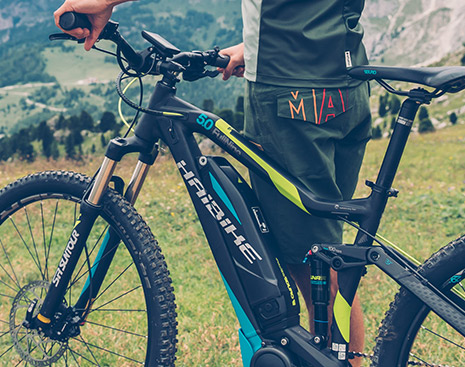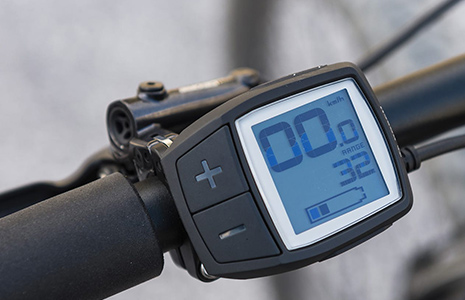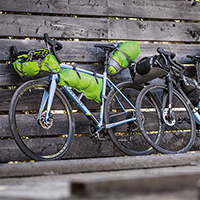E-Bike Batteries: FAQs
TO BATTERY – FAQS, CHARGING COSTS, RANGE ETC.
To stay in the fast lane for as long as possible, you’ll need a charged battery. The battery is either attached inside the main frame or onto the luggage rack of the bicycle. The most commonly used batteries on e-bikes are lithium-ion (Li-Ion) batteries and vary from manufacturer to manufacturer in size, weight, energy capacity, price and battery management systems. They can be conveniently charged at their own outlet. Allow for charging times between 2- 5 hours to fully recharge an empty battery.
Do you already know which e-bike battery you need? Then get it here.
Find Bosch e-bike batteries here.
EVERYTHING YOU NEED TO KNOW ABOUT YOUR E-BIKE BATTERY
CHARGE, TURN ON AND GO
Before the ride can start, the battery should be charged. Depending on the model, the batteries can be removed from the bike for easy charging in your own home. In order to use the energy of the accumulator, most must be switched on via a switch or push button. Then, a charge indicator should light up on the battery or near the on/off switch. In the manufacturer's manuals you’ll find all the specific information about the battery and the charge gauge you’ll need. Now just sit up, turn on your display, select the support and ride modes and you’re ready to go.
THE IMPORTANCE OF ENERGY CONTENT IN WATT-HOURS
The most important information that makes batteries of different manufacturers comparable is the energy capacity, which is given in watt-hours (Wh). The larger this value is, the more miles you can travel with one charge (range). Batteries with 250 to 600 Wh are usual. However, a higher value also means that an identical battery of the same brand is heavier. You can often tell by the battery name how much energy your battery has, but it's also marked clearly on the battery. Here you’ll also find information on the voltage (V) and the capacity in ampere-hours (Ah). The product of both values gives the exact value in watt-hours.
WHAT DOES IT COST TO FULLY CHARGE THE BATTERY?
In order to benefit as much as possible from the pedal assist on your e-bike it’s best to recharge the battery after every ride. The low electricity costs that are incurred depend on the energy content of your battery, the frequency of charging and, of course, your individual electricity provider.
Modern batteries have an energy capacity of 250 to 600 Wh. Currently, the average price per kilowatt hour is around 14 pence in the United Kingdom (2017). This results in the following electricity costs per charge:
| Energy capacity of the battery | Electricity costs per full charge | Electricity costs for 500 charges | Electricity costs for 1000 charges |
|---|---|---|---|
| 300 Wh | 4.2 p | £21 | £42 |
| 400 Wh | 5.6 p | £28 | £56 |
| 500 Wh | 7 p | £35 | £70 |
| 600 Wh | 8.4 p | £42 | £84 |
WHAT SHOULD I DO IF I RUN OUT OF JUICE ON THE WAY?
If you’ve planned a longer tour on your pedelec, you should bring a spare battery with you or check in advance if there are charging stations along the way where you can recharge your battery. Of course, you can also ride your e-bike without engine assistance. If you aren’t used to this, the extra weight of the engine and battery may feel as if you’re riding with the handbrake on, but the bike will remain mobile – allowing you to ride to the next charging station.
HOW LONG SHOULD THE BATTERY LAST?
Unfortunately, a battery won’t last indefinitely. Many brands give a ballpark figure of around 1000 charge cycles, but calculate this based on an assumption that you always charge a completely empty battery, which is rare in practice. As a result, this should mean that you’ll be able to recharge the battery many more times before it stops working. Over time, the maximum range that you can achieve with once charge will naturally reduce. In this case, it’s best to get a spare battery to compensate for possible range problems. Depending on the manufacturer, use and care, a battery can last for 2 to 5 years, after which it should be disposed of properly.
Increase the life of your battery:
- Store dry and at a temperature between 0-20 degrees
- Don’t park your e-bike in bright sunlight
- Don’t leave it outside when temperatures are below freezing
- Always use the manufacturer's charger
- If possible, recharge the battery after every ride
- "Retracting" the battery: in the beginning it may be helpful to run the battery completely several times (3-5 times) to be able to use the full power in the long term
- After "retracting", only rarely unload the battery completely
- Charge the battery at least once every 6 months
- Optimum storage battery life: 30-70%
- If used in winter, store a removable battery in the house and attach it again shortly before the start of your journey
- Never immerse in water or clean with a strong jet of water
- Regularly clean off dirt with a damp cloth
- Keep contacts clean

HOW FAR CAN I GO WITH A FULLY CHARGED BATTERY?
Can I travel 50 miles on a single battery charge or will it take me as far as 120? When choosing an e-bike, the range greatly influences the purchase decision for most people. Therefore, manufacturers try to specify as realistically as possible, the maximum that may be possible with a full battery charge. But please don’t be disappointed if you don’t reach the specified amount of miles.
-
Because an e-bikes maximum range depends on many different factors:
- Energy capacity of the battery (300 or 500 Wh)
- Engine
- Rider's weight
- Chosen support level (e.g. Eco, Tour, Sport, Turbo)
- Wind (headwind, tail wind)
- Starting frequency
- Terrain (road or off-road)
- Frequency and length of uphill sections
- Bike type
- Posture on the bike
- Tyre tread
- Cadence
- Efficient use of your mechanical gears
- Connected electronics, such as bike lights or onboard computers
- Age and use of the battery

From the large number of variables you can see why it’s extremely difficult to give exact range information. Drive manufacturer Bosch sheds a little light on the matter on its website. There you’ll find a range calculator which tries to take into account almost all the factors mentioned. In just a few steps you should be able to find out the distances you could cover with your engine/battery unit.
WHAT CAN YOU DO TO INCREASE THE RANGE OF YOUR BATTERY?
As you saw in the previous section, the actual range of your e-bike depends on many factors. But there are also some things you yourself can do to get as far as possible on one battery charge.
- Only use the highest level of power assistance on climbs and when starting
- Start with a lighter gear and shift evenly to the next heavier when accelerating
- Regularly check your tyre pressure, if it’s too low, the rolling resistance is too high
- Check your riding position, because sometimes tweaks to the saddle height mean less wind resistance
- Avoid heavy gears on ascents, switch to a lighter one in time
- Avoid extra weight. Each kilo added by packed-out bags uses more energy
- Ride proactively, brake better and accelerate more gently
- Use paved roads and avoid bumpy roads
- When possible, ride faster than 15 mph, as then the power-assist stops

































